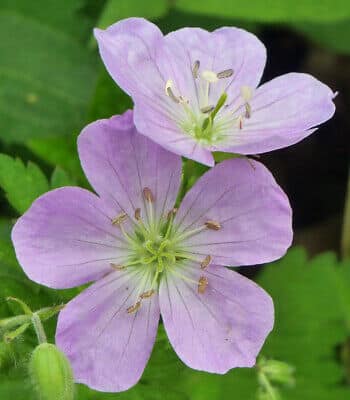Geranium maculatum
By MaryAnn Fink/ The Native Explorer contributor/ Pollinator Junction/ Museum of Transportation
Copyright May 2022
Geranium maculatum’s lavender pink blooms are simple and lovely. Often waiting to dress up in her blooming best untill the breezes have warmed abit, she is fashionably late.
Typically it is mid-spring in Missouri when you will see her in flower, blooming for several weeks. Her flowering period may decrease in years when it warms up quickly in Spring. (When it feels like summer to you-it probably feels like it to your spring plants too!).
Sometimes this geranium is in the shady recess, slowly waving in the wind, other times, on a breezy day, her blooms are bouncing like little children on the school bus. My favorite placement is when she’s amid other relaxed perennials.
Geranium maculatum doesn’t care much if she’s in sun or shade as long as there is enough moisture to support her “alittle too big” leaves. These loose green tresses giving her a gentle casual look.
Maybe because of the sensitivity to air movement and or her lax foliage, she makes me think of a little girl in her mother’s dress, dancing in front of a mirror to a tune only she hears.
Unlike many other spring flowers that quickly go dormant till the next spring, Geranium maculatum sometimes finds enough strength to keep some of her leaves visable for part if not all of the growing season.
Her dome of green slowly expands with the passing of years and sometimes new geranium seedlings will establish in the vicinity. Since she’s a long lived perennial, she dies down for winter and returns with fresh foliage and flowers the following year. She does it all rather nonchalantly as the years pass. I knew a gardener that swore her original geranium was over 20 years old!
Her pink petite saucer-shaped blossoms face up like little satelite dishes. Pretty little veins radiate from the center, acting as runway guides for pollinators.
She supplies BOTH nectar and pollen. Butterflies, bumblebees, cavity nesting bees and ground nesting bees all make food visit to this geranium. An Andrenid bee, Andrena distans, is a specialist pollinator (oligolege) of Geranium maculatum.
There has been some research done on this Missouri native. It seems she has an interesting way to avoid self pollination. The stamens ( boy parts) are arranged in a circle around the center style. Some of them developed sooner than others, extending the opportunity for pollen pick up. (Spring weather can dampen pollen, wash it away and basically affect the pollination enthusiasm of many pollinators)
The stigma ( girl parts) developed after the boys have shared their pollen and have fallen away before making their pollinator play for attention. The flowers can be at all different stages, extending the bloom time and the offering at each flower and all the while preserving gene diversity!
Groom after first flush of flowers start to fade. Trimming this lovely requires a gentle hand so that she can come back into bloom with a minimum down time. A light trimming will just help shape her into a slightly tighter but still loose bundle of leaves.









